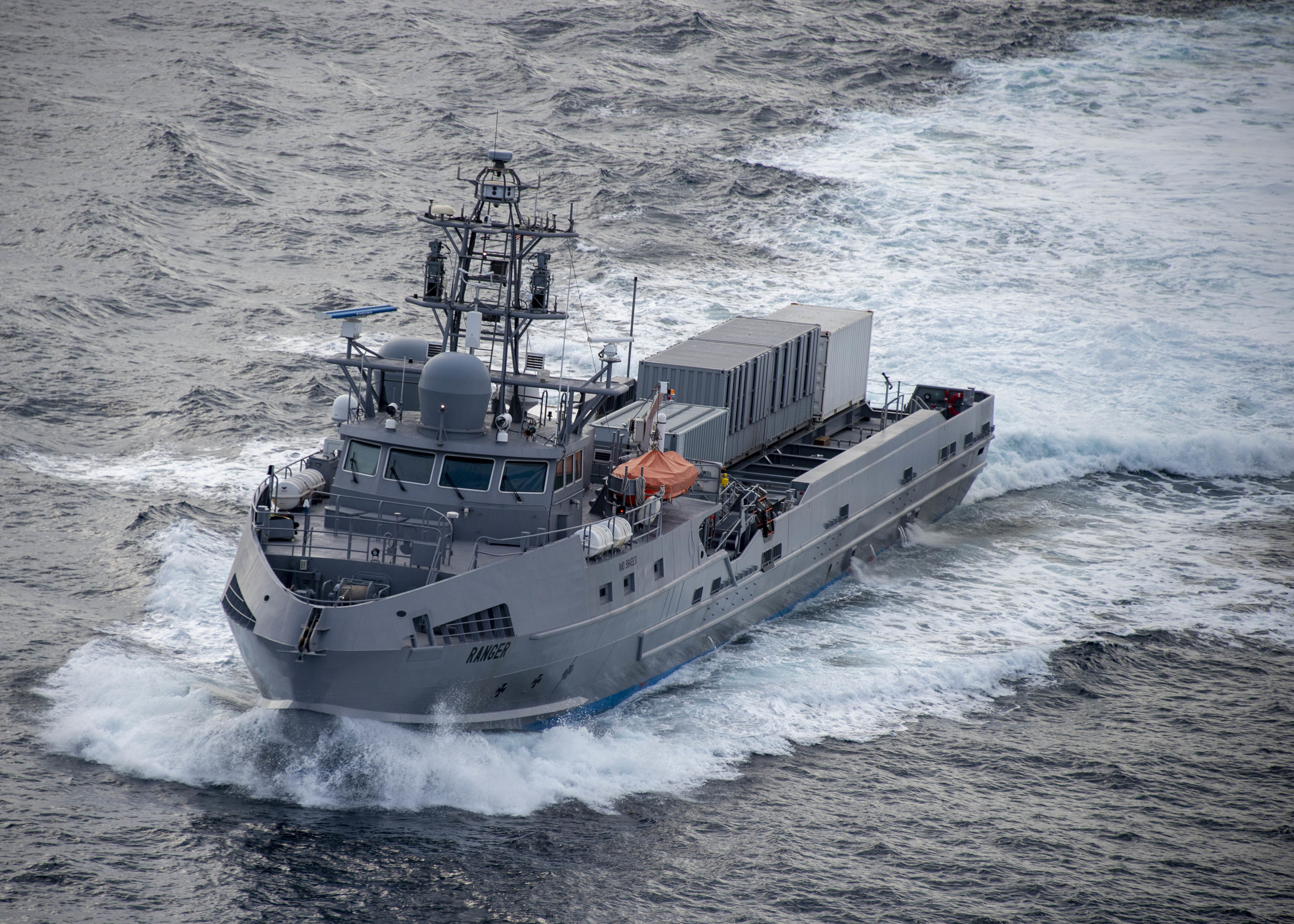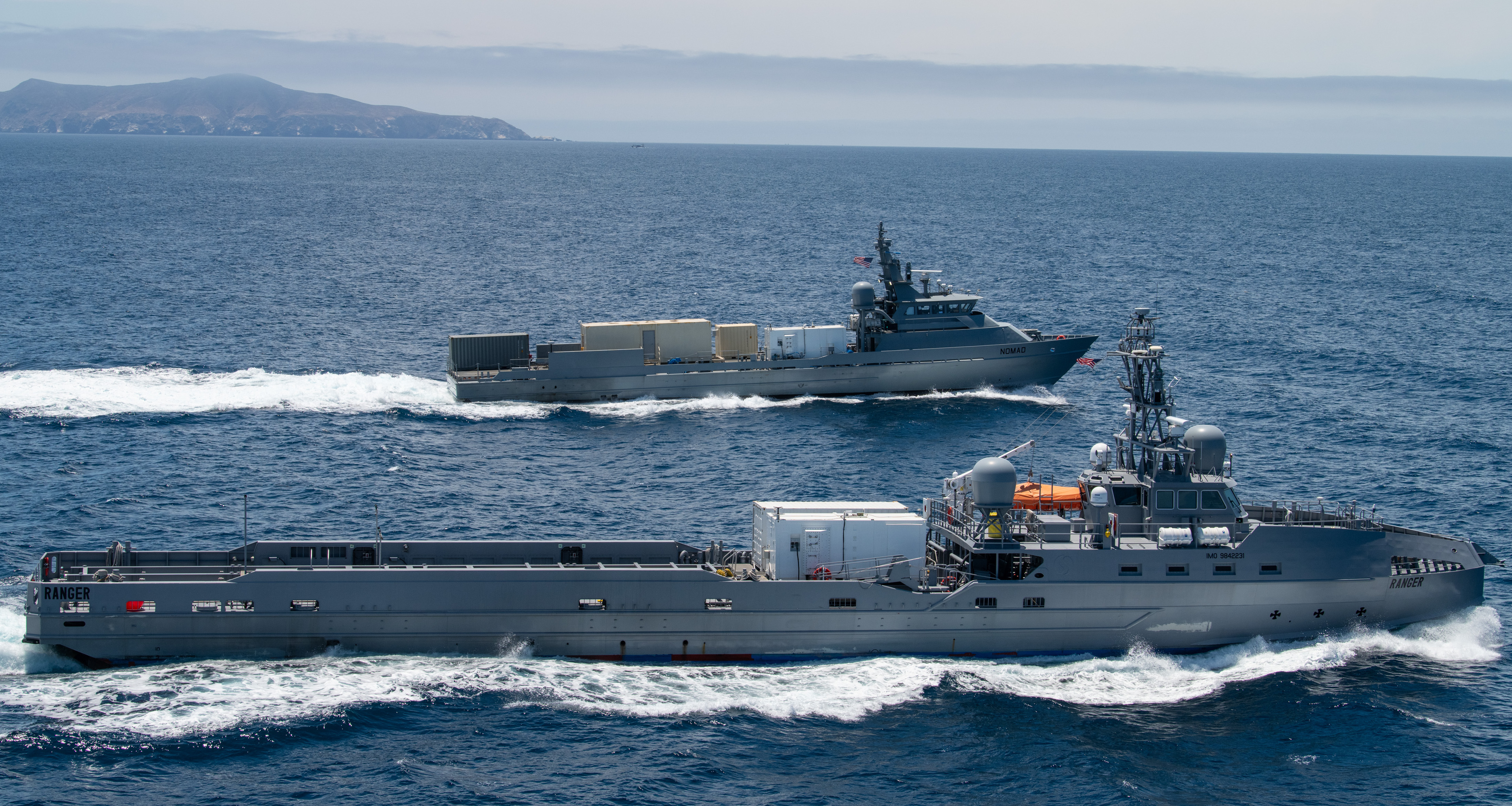
NATIONAL HARBOR, Md. – The Navy will finish the requirements for its future fleet of Large Unmanned Surface Vessels this year, Chief of Naval Operations Adm. Mike Gilday told USNI News on Tuesday.
“The [capabilities development document] is being developed right now to deliver in 2023. That actually lays out the specific requirements for LUSV,” Gilday said during a press conference at the Navy League’s Sea Air Space symposium.
The CDD lays out the key requirements for the LUSV – thought to be about the size of an offshore support vessel for the oil and gas sector – that will go to industry.
The Navy will buy its first LUSV in 2025, with a total of nine to go under contract by Fiscal Year 2028, according to the service’s five-year shipbuilding outlook issued with the FY 2024 budget proposal. The Navy has set aside $117.4 million in its budget request to continue developing prototypes to help refine the requirements.
Under congressional direction, the Navy must create a land-based test site for the LUSV power plant that will run for 30 days before the service is authorized to contract the first ship.
As part of the CDD process, the Navy will first give industry the specific requirements for the LUSV propulsion system ahead of creating the shore-based power plant, Gilday said.

“Instead of standing it up in Philadelphia with an engineering plant … we are having industry, based on our specs, do the testing and we will decide how we’re going to put that engineering plant together and then make the investment in a land-based test site up in Philly. We’ll run that engineering plant just like we’ve done with the DDG, just like we intend to do with frigate,” Gilday said.
As part of the Navy’s emerging Distributed Maritime Operations (DMO) framework, “the LUSV will be capable of weeks-long deployments and trans-oceanic transits and operate aggregated with Carrier Strike Groups (CSGs), Amphibious Ready Groups (ARGs), Surface Action Groups (SAGs), and individual manned combatants,” reads the Navy’s FY 2024 budget documents.
The LUSV will fire its weapons at the direction of a person aboard a guided-missile warship or other assets, according to the service. As a proof of concept, the Navy and the Pentagon’s Strategic Capabilities Office tested the firing of a Standard Missile 6 remotely from a modular launcher aboard USV Ranger in 2021.
“The vessel will be incapable of payload activation, deactivation, or engagement without the deliberate action of a remote, off-hull human operator in the command and control loop,” reads the Navy’s budget documents.
“The program will integrate current Navy combat systems programs of record that have been adapted to enable remote monitoring and operational control from an off-hull command and control point, and will not be equipped with components that would enable payload engagement from onboard the vessel.”
In non-combat scenarios, the LUSV will be minimally manned to assist in extended voyages, monitor the autonomous systems and provide protection to systems aboard.
“We are definitely going to have a requirement for crew support on LUSV, or a smaller crew, to handle those things that are just not quite there with maneuvering critical situations,” Rear Adm. Casey Moton, the program executive officer for unmanned and small combatants said at Sea Air Space.
“We are trying to push the boundaries like we are pushing industry … we don’t want there to be this crutch that we’re just going to fall back on the crew, right, but at the end of the day, we’re fairly close on the autonomy.”

The Navy’s hybrid future fleet will be split between crewed and uncrewed vessels to provide both the sensors and weapons capacity needed for the extended ranges required to operate under DMO, officials have said.
“By the middle of this century … up to 40 percent of the fleet will be unmanned,” Capt. Scot Searles, program manager for unmanned maritime systems said at Sea Air Space.
“There’s a clear demand signal to develop and field it and it has to be affordable. That’s the thing that we’ve got to key on now, when it’s [in] this nascent stage of development, make it affordable, lethal, scalable, and connected.”
Part of the affordability will come from relying on commercial standards for much of the systems aboard.
Much of that testing will happen on the service’s Ghost Fleet Overlord prototype vessels, like Ranger and its sister ship Nomad. The commercial ships were converted to operate autonomously.
The service took delivery of the third Overlord ship of Mariner last year. The fourth, Vanguard, is still under construction.
In 2020, the Navy awarded $42 million in contracts for LUSV studies to shipbuilders Austal USA, HII, Fincantieri Marinette Marine, Bollinger Shipyards, Lockheed Martin and ship design firm Gibbs & Cox. Each company was awarded about $7 million.





